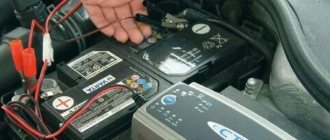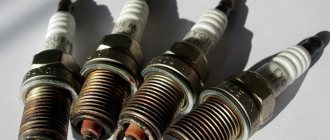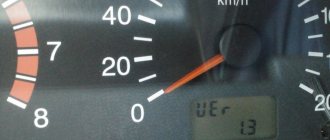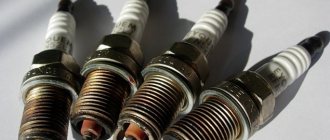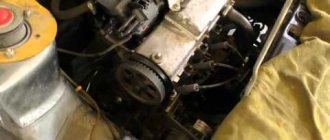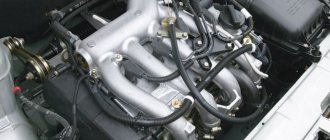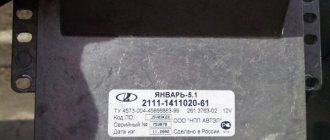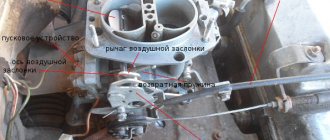Everything that had not been replaced was also gone: the modular unit, the spark plugs, and the crankshaft sensor. Does not help! Please tell me!
- There is no plus from the ignition switch on the VAZ 2109 - 13 answers
- VAZ 2108 starts and stalls after 1-2 seconds – 9 answers
- Why is there no spark and the fuel pump does not work, the check does not light up, VAZ 2115? – 8 answers
- Failure in acceleration mode VAZ Samara – 6 answers
- Why does the VAZ 2109 twitch? – 4 answers
Here you need to check everything along the chain, starting with whether power is supplied to the coil (babin) when the ignition is turned on, and further along the chain. The most ideal option is to go for diagnostics, you will save both money and time.
What to do if the car does not start? Almost every motorist has faced this question. In fact, everything is very simple. Air, spark and fuel should be checked. If you already know the cause of the problem, namely, there is no spark on the VAZ 2109 injector, then read this article.
So, the VAZ 2109 is equipped with a contactless ignition system.
No need to guess too much - you need to use the following devices
The first device is A3-1 - emergency ignition . You can use it in the rain or when driving through puddles (to warm up or dry the spark plugs) to check the electronic switch or when the hall sensor fails. In other words, emergency ignition is a substitute for a hall sensor, but with a speed limit of up to 90 km/h.
The second device – MD-1 – instant diagnostics . Used to check the functionality of the hall sensor, ignition coil and ignition switch. To begin with, it is better to use MD-1. We connect it instead of the switch and turn on the ignition, but we don’t start the car!
- if the “P” LED is on, the ignition switch and ignition relay are operational
- LED “K” is on – the ignition coil is working
- turn on the starter: if the “D” LED blinks, it means the hall sensor is working
Let's discuss such an issue as setting the ignition of the VAZ 2109 (carburetor)
In general, repairing a VAZ 2109 carburetor is more like some kind of “find the fault” quest. Because there can be many reasons for the lack of spark.
Among the main ones are the following:
- Faulty switch.
- Problems with the Hall sensor.
- The coil needs to be replaced. Or the wires going to it have oxidized. They need to be cleaned and the spark checked again.
- Sometimes the cause may be a faulty ignition switch. To check it, use the simplest method. Take an ordinary car light bulb. One contact goes to “B+” on the coil, the second to ground. Now you can turn on the ignition. If the light does not light up, the lock is to blame. If it lights up, check the coil.
Possible reasons for absence
Most modern cars are equipped with an abundance of sensors. They make the car owner’s life easier and make repairs more difficult. In the electronics responsible for the operation of an injection engine, there are, of course, several sensors responsible for the spark formation process. However, the prerequisites for the absence of a spark (VAZ-2110, injector, 8 valves) usually occur in other components. There are a number of types of possible breakdowns. The first includes various problems in the car’s fuel system. This includes malfunctions when fuel is not allowed to enter the cylinders or the supply is malfunctioning.
If there is no spark (VAZ-2110, injector, 8 valves), then you will like it due to the fuel system. Often the pump relay or the submersible element itself burns out. The test is done by ear.
Next come the tasks related to the electronic part. These are some of the most common defects. With such breakdowns, an electronic discharge does not reach the spark plug. The mixture will not be set on fire. In the midst of global problems - a complete failure of the engine, a broken timing belt. These defects should not be dwelled upon carefully.
Bringing the car back to life
As for why a spark disappears, everything is probably very clear. Now, it would not be amiss to consider the order of her return. The reality is that in most cases, getting the spark back is a simple matter and just involves carefully checking the broken car. To be more precise, to normalize sparking it is required:
- Firstly, check the spark on the injector using the method described above, make sure that it has disappeared, and, at least indirectly, try to determine the cause of the malfunction;
- Next, it is enough to assess the current circumstances and act based on them. As typical situations, we suggest considering solutions to the following problems:
- the spark plug is wet, the presence and strength of the spark are unimportant, the carbon deposits are correct (brick color) - wipe the part and screw it back in;
- the spark plug is wet (not always) and the carbon deposits are incorrect (white or black) - clean, dry the part and try to start the engine, if there is no result, change the spark plug and deal with problems in the fuel system (cleaning the injector, checking the ECU, etc.);
- the spark plug is wet, there is no spark at all, the color of the soot is not important - we try to change the part, if there is no result, we check the ignition system and the operation of the injector.
In principle, in theory there are no particular difficulties in repairs of this kind. Despite this, it often causes difficulties in implementation for inexperienced motorists. To solve these, you need to act in the order described above, but if something doesn’t work out, it’s better to turn to professionals at a service station. This approach to repairs will not only save time, but also guarantee trouble-free operation of the car in the future.
Perhaps this concludes the most important information on today’s issue. We hope that the material presented was useful to you and provided answers to your questions. Good luck in operating and maintaining your car!
Stage one
Usually the symptoms of difficulty are the following: the starter rotates regularly in its own standard mode, but the engine does not want to start. One of the most possible circumstances is a fuel pump that does not start. When on injection “tens” it is submersible and is located directly in the tank.
There is an option to check the element by the presence of operating sound. Turn on the ignition - there should be a rumble in the area of the rear seats. He is absent from time to time. In our version, you should check the fuses. The VAZ-2110 is a fuel-injected car, and the fuse box is located on the side of the center console of the unfamiliar front passenger. You need to unscrew the fasteners, then remove the cover, check the fuses for functionality and change them as necessary. In this case, the elements are 100% serviceable, then you need to check whether the relay will turn on, both the main one and the fuel pump. Of course, you can feel the moment of switching on with your finger. A corresponding click will also be heard.
Battery check
A characteristic feature of a problem battery is a change in the sound of the signal. Even if there is a problem with the battery, the lights on the dashboard usually react when the starter rotates. In such a case, the reason why there is no spark may be a low battery charge or broken contact at the terminals.
If the terminals become oxidized, they should be cleaned and securely fastened. You can also apply graphite grease to them; it will prevent the terminals from oxidizing in the future. If the battery is simply discharged, it must be fully charged.
Stage two
If there is no spark on a VAZ-2110 (injector, 8 valves), then spark plugs are often the cause. What, they are inspected if the fuel pump is working. It is best to use a spark gap for testing. If the current is distributed over two spark plugs, then there will certainly be a breakdown to ground.
You can find out why there is no spark on the VAZ-2110 (injector, 8 valves) using a faulty controller. It is also possible that the wires from the controller to the ignition coil will break. If spark on all coils, you should check the power supply. Typical specifications are up to 200 kΩ.
About spark plug gap
Over time, the gap between the electrodes increases. The normal parameter is from 0.7 mm to one millimeter. You can check this gap using a special feeler gauge.
The same is used for setting valve clearances on carburetor engines. So, if a parameter does not meet the norm, it should be adjusted. To do this, you should use a negative screwdriver. To reduce the gap, press the end of the plug onto the top electrode of the spark plug. With your other hand, hold the part itself. If you “overdid it”, it doesn’t matter – everything can be returned back. To do this, bend the electrode with the edge of a screwdriver (it bends quite easily) and check the distance again. It is worth noting that with a correctly set gap, you can not only ensure trouble-free engine starting, but also reduce fuel consumption by 5 percent. Also the car will run smoothly. After all, the mixture is ignited exactly at the moment when it is necessary. And the last thing is the resource of the candles themselves. If the gap is higher or lower than normal, the risk of breaking through the insulator increases significantly. As for the replacement schedule, it is about 40 thousand kilometers. It is recommended to replace the high-voltage wires along with the spark plugs.
Ignition module and coil
There is an option to check the error codes that are in the car’s memory. On the contrary, the ECU does not have a diagnostic function; a working module must be installed in advance.
It is likely that the wire to the ignition coil has broken or there are breaks in its winding. If a VAZ-2110 car does not have a spark (injector, 8 valves) on 2 wires, then the cause is a non-working ignition coil, also called a controller. In two cases, of course, there is a possibility of high-voltage wires breaking. The myth option is worth checking first. Look at the resistance level.
If there is no electronic discharge for some reason, then the element must be replaced. The system has an ignition module. Therefore, a useful operation would be to check the “minus”.
No spark on an injection engine or an engine with a carburetor: how to check
Checking the spark is possible using several methods: to ground, using a multimeter, or a special tester on a piezoelectric element. The first method is the simplest. The body of the unscrewed spark plug is brought to the metal (usually the engine cylinder block), after which the engine is cranked by the starter and the presence of a spark is analyzed.
Please note that this verification method cannot be used when diagnosing injection cars. The fact is that a car with an injector has an ECU and other electrical equipment that is quite sensitive and can be damaged. The second method allows you to better assess the condition of the spark plug, identify breakdown, etc.
The use of a special tester is a method of checking the spark on injector cars, reminiscent in its principle of checking by analyzing the spark breakdown to ground (the first method). In this case, the risk of burning the control unit is minimized. Now let's talk about how to check the spark on a fuel-injected engine
The second method allows you to better assess the condition of the spark plug, identify breakdown, etc. The use of a special tester is a method of checking the spark on injector cars, reminiscent in its principle of checking by analyzing the spark breakdown to ground (the first method). In this case, the risk of burning the control unit is minimized. Now let's talk about how to check the spark on a fuel-injected engine.
As mentioned above, a special spark arrester device is used to check the spark on the injector. The presence of this solution during diagnostics allows you to accurately localize the problem area, since the ignition spark may not be on the spark plug, on the distributor or on the coil. Also, there may be no spark in only one, several or all cylinders of the engine.
A complete lack of sparking indicates possible problems with the controller, ignition module, coil or center wire. Diagnostics should begin by checking the fuses. Then you should evaluate the condition of the ground contact, and also check the high-voltage wires.
If there is no spark at the ignition coil, then the functionality of the high voltage wire should be checked. The specified wire must be checked for insulation integrity, have no breakdowns, burnt areas, etc. Detection of any defects is grounds for its replacement.
Also, in the process of diagnosing the ignition system, you should inspect the spark plugs. This must be done if electricity reaches the candles. On carburetor cars, it is enough to remove the spark plug wire, and then bring it closer to a metal surface (for example, a car body) by half a centimeter. Then you need to turn the starter and make sure that there is a spark running between the wire and the metal surface. The spark itself should also have a certain intensity, be white with a slight bluish tint. If no deviations are noticed, then the spark plugs are working. The reason that there is no spark at the spark plug may be the ignition coil.
If you notice problems with the spark plugs, then you need to pay attention to the spark plug contacts. These contacts must be free of contamination. Let us add that if deviations from the norm are noticed, it is optimal to immediately replace the spark plugs
The absence of this option will indicate the need to clean the contacts
Let us add that if deviations from the norm are noticed, it is optimal to immediately replace the spark plugs. Failure to do so will indicate the need to clean the contacts.
Possible errors in VAZ injectors
Codes, of course, indicate defects in all parts and components in the car. In most cases this is due to sensors. Temperature sensors suffer in particular - they overheat. Car owners also complain about the injectors. Problems arise due to breaks in the circuit. Once completed, they do not have the basis to work properly. This also includes the popular breakdown on the VAZ-2110 - no spark. The 8 valve injector cannot start normally due to this.
Diagram of the engine control system (ECM) VAZ-2113, 2114 and 2115
- controller;
- – block of the ignition system harness to the ABS cabin group harness;
- – diagnostic block;
- – immobilizer warning sensor (APS);
- – immobilizer control unit (APS);
- - ignition coil;
- - spark plug;
- – nozzles;
- – electric fuel pump;
- – block of the ignition system harness to the electric fuel pump harness;
- – block of the fuel level sensor harness to the ignition system harness;
- – block of the ignition system harness to the injector harness;
- – block of the injector harness to the ignition system harness;
- - speed sensor;
- – idle speed regulator;
- – throttle position sensor;
- – coolant temperature sensor;
- – mass air flow sensor;
- – camshaft position sensor (phases);
- – oxygen sensor;
- – crankshaft position sensor;
- - knock sensor;
- – solenoid valve for purge the adsorber;
- – block of the ignition system harness to the instrument panel harness;
- – controller power supply fuse;
- – ignition relay;
- – ignition relay fuse;
- – fuse for the power supply circuit of the electric fuel pump;
- – electric fuel pump relay;
- – electric fan relay;
- – block of the ignition system harness to the air conditioner harness;
- – pads of the ignition system harness to the front harness;
- – electric fan of the cooling system;
- – block of the instrument panel harness to the ignition system harness;
- – ignition switch;
- – instrument cluster;
- – on-board control system unit;
- - starter relay;
- – mounting block;
Other faults
If the starter does not spin, the spark disappears between the ignition switch and this element. This often happens when the battery is discharged or faulty. When tested, a regular battery indicates approximately 11.8 V. A faulty ignition cylinder will immediately appear just when the driver inserts and turns the key. If turning the key is very easy or difficult, you need to change the lock. The starter relay or the accounting ignition system is also one of the likely circumstances of the lack of a spark. But there is no way to check these nodes without the help of others. The “retractor” device may be stuck in the starter. In this case, the spark is lost along the way. Experienced car owners hit the starter with a key, or in other words, with a hammer, to return the spark. However, this is only relevant at the site of the breakdown.
What to do if there is no spark in a VAZ-2110 car? Check the starter in the garage using a battery. If you press the body of the device to the “minus” of the battery, and stretch the “plus” wire to the “retractor”, then the device comes to life. Often the spark may disappear where power is supplied to the starter. It is advisable to inspect this circuit with a multimeter. You can't do it alone - the assistant works with the key while taking measurements.
Low voltage circuit
Using a 12V lamp, you can check the low voltage circuit. The lamp must be connected with the first contact to the low voltage terminal, and the second to the car body. Next, you need to close the distributor contacts and start the ignition. If the circuit is OK, the lamp will light when the contacts open and go out when the contacts close.
If the lamp does not light up when the contacts are opened, this means that the problem is in the low voltage wiring or in the ignition coil, or rather, in its winding.
High voltage wires
Next you need to visually check the high voltage wiring. There should be no visible damage or disruption of the insulating layer. If the wiring is in good condition, you should check the wiring to the spark plugs.
To do this, you need to remove the tip from the spark plug wire, bring it to a place on the body without paint and start the car. When the starter rotates, a bright spark with a bluish tint should appear. If this does not happen, you should check the ignition coil.
At the same time, the spark plugs do not fail. If there is a spark in the spark plug wiring, it is possible to check any of the glow plugs. To do this, you need to unscrew the suspicious spark plug from the block and put the spark plug wire on it. Next, you should touch the place on the body without paint with a metal part and, by rotating the starter, determine whether there is a spark or not.
Replacement of spark plugs must occur in a timely manner, in accordance with the maintenance of your car model. For VAZ-2115 - approximately every 20 thousand kilometers.
Fuel system problems
Lada Kalina Hatchback MyLittleFriend Kalinich Logbook Floating speed or Replacing the idle air control
Among the elements of the fuel system, the following factors influence engine starting:
- presence of gasoline in the tank;
- the integrity of the fuel lines under the “belly” of the car;
- cleanliness of the filters: coarse cleaning (located in the tank) and fine cleaning (located under the car, to the right of the spare wheel compartment).
Also included in this category are electrical components that are directly related to the fuel supply. This is an electric fuel pump and a fuel pump relay.
Before checking other methods, you must be completely sure that the VAZ 2114 with an injector is filled. “Yes, there are still five liters there” according to the indicator on the tidy or “I filled it up yesterday, I couldn’t spend that much” are not suitable. The gauge may be lying, and there may be leaks in the tank or fuel lines. Carefully check the car for fuel leaks; just in case, fill in 5-7 liters of gasoline from a canister.
The mesh in the tank rarely gets clogged, leave this option for last, but it’s worth trying to change the fine filter if electrical problems are ruled out.
The operation of the fuel pump is checked by ear (after turning the key, its operation should be heard; if not, the pump has “died”, or the pump relay, or a wiring break). According to the manual, you need to connect a pressure gauge to the fuel system. If the pressure does not stay within 2-2.5 atm, the VAZ 2114 will not catch due to insufficient fuel pressure.

